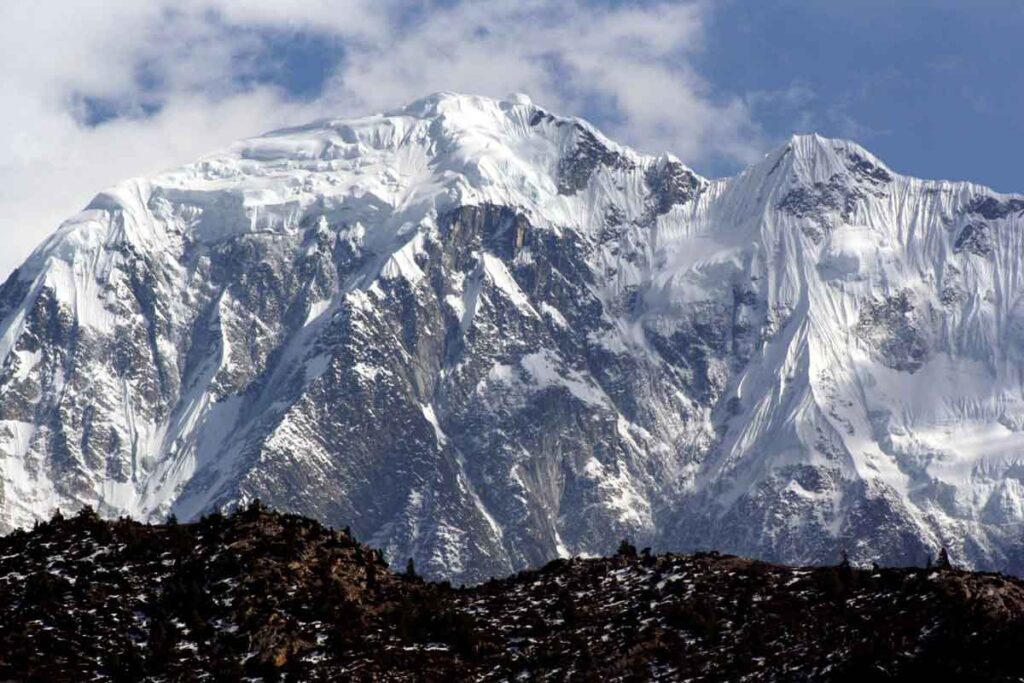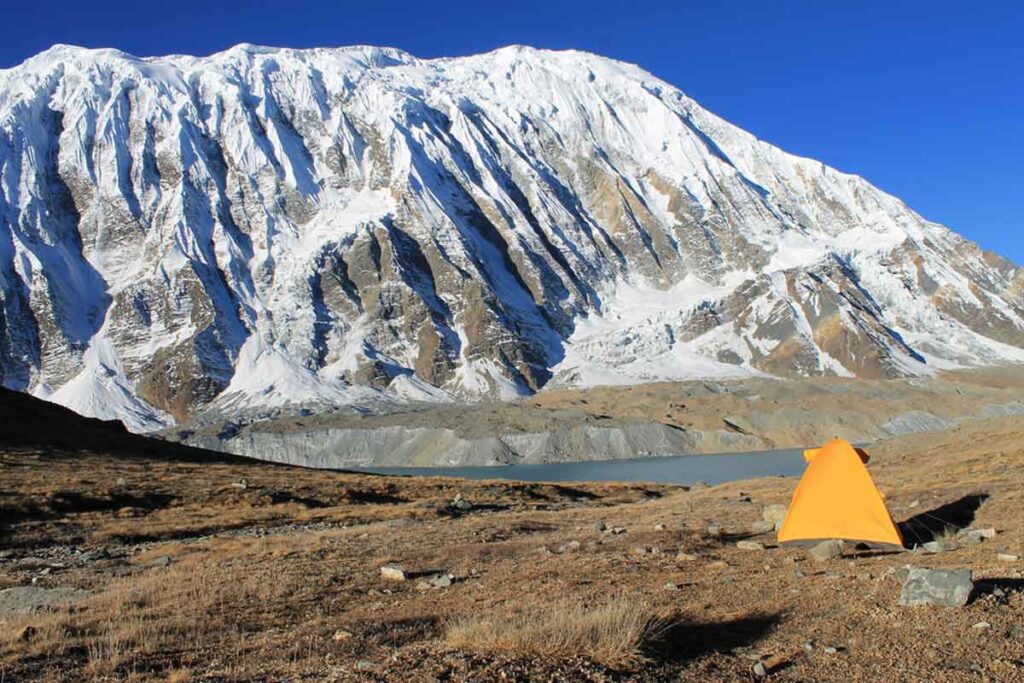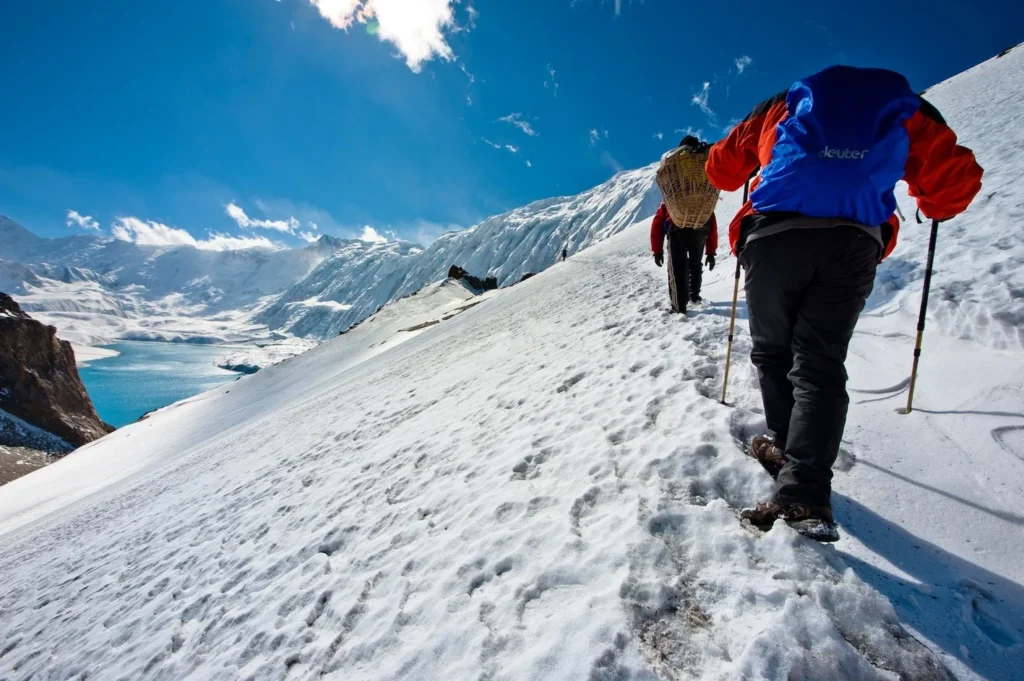Tilicho Peak Expedition (7,134m)
- Home
- Tilicho Peak Expedition (7,134m)

The Tilicho Peak Expedition (7,134m) is one of Nepal’s most stunning and challenging mountaineering adventures, located in the spectacular Annapurna region of the Himalayas. Rising above the turquoise-blue Tilicho Lake—one of the world’s highest lakes—this peak offers climbers an extraordinary blend of high-altitude adventure, natural beauty, and cultural richness.
The expedition follows the classic Annapurna Circuit trail through lush valleys, alpine meadows, and ancient Manang villages before reaching the base of Tilicho Peak. The mountain demands technical climbing skills, physical endurance, and sound acclimatization, making it ideal for experienced mountaineers looking to climb a 7,000-meter Himalayan peak in a remote and pristine setting.
At Nepal Treks and Tour, we organize this expedition with a strong emphasis on safety, acclimatization, and professional guidance, ensuring every climber has a rewarding and secure experience.

Welcome to Nepal! Upon arrival at Tribhuvan International Airport, our representative will greet you and transfer you to your hotel. Evening briefing and equipment check.
Spend the day preparing for the expedition. Attend a pre-trip meeting, finalize gear, and explore the UNESCO World Heritage Sites of Kathmandu Valley.
A scenic drive along the Trishuli and Marshyangdi rivers brings you to Besishahar — the starting point of the Annapurna Circuit.
Travel through winding mountain roads surrounded by waterfalls and dense forests to reach Chame, the district headquarters of Manang.
Begin trekking through pine forests and steep ridges. Magnificent views of Lamjung Himal and Annapurna II accompany the trail.
Trek through the Marsyangdi Valley while enjoying views of Tilicho Peak, Annapurna III, and Gangapurna. Overnight in Manang village.
Rest and acclimatize in Manang. Explore local monasteries, visit the Himalayan Rescue Association center, or hike to Gangapurna Lake.
Follow the trail toward the ancient Khangsar village, known as the “Last Village of Nepal” before Tilicho. The landscape transitions into dry alpine terrain.
A challenging hike across rugged terrain and landslide-prone slopes leads to Tilicho Base Camp, the gateway to the lake and the peak.
Trek through rocky sections toward Mesokanto La Pass — a high-altitude campsite ideal for preparing climbing gear and resting before the ascent.
Multiple camps will be established to ensure proper acclimatization and safety.
Retrace the trail, descending through rugged terrain and scenic landscapes back to Manang.
Descend along the Marsyangdi River, passing beautiful waterfalls and forested trails to reach Tal village.
Drive back to Kathmandu. Check into the hotel and rest after the expedition.
Relax, explore the city, or enjoy a celebration dinner with the expedition team.
Transfer to Tribhuvan International Airport for your onward journey.
The best time for the Tilicho Peak Expedition is during spring (April–May) and autumn (September–October) — the two prime climbing seasons in Nepal. These months offer stable weather, clear skies, and excellent climbing conditions, making them ideal for both trekking and high-altitude ascents.

Spring is one of the most popular times for the Tilicho Peak Climb. As the snow begins to melt and the weather warms up, the routes become more accessible and stable. The air is crisp and clear, offering spectacular views of the Annapurna, Dhaulagiri, and Manaslu ranges.
Daytime temperatures are moderate, and nights are cold but manageable.
The rhododendron forests bloom along the trail, adding vibrant color to the journey.
Ideal conditions for acclimatization and gradual ascent.
Autumn is equally favorable for climbing Tilicho Peak. Following the monsoon, the air is clean and visibility is exceptional. The mountains appear sharp against deep blue skies, providing perfect photography opportunities.
If you’re planning to climb Tilicho Peak, April to May and September to October are the most suitable months for a successful and safe expedition. During these seasons, we ensure well-coordinated logistics, reliable weather monitoring, and optimal climbing support for the best summit experience.
If you need any further information, please feel free to contact us via email at [email protected] or by phone/WhatsApp at +977-9851013072.
A: Tilicho Peak (7,134 m) lies in the Annapurna region of central Nepal, just north of the famous Tilicho Lake, one of the highest lakes in the world. The mountain is part of the Annapurna Himalayan range and can be accessed via the classic Annapurna Circuit Trail through Manang.
A: The Tilicho Peak Expedition is considered a technical and challenging climb. Climbers should have prior experience with ice, snow, and mixed terrain. The ascent involves steep snow slopes (up to 55°), fixed rope sections, and glacier crossings. Previous experience on 6,000m or 7,000m peaks is highly recommended.
A: The best seasons for the Tilicho Peak Climb are spring (April–May) and autumn (September–October). These months offer stable weather, clear skies, and ideal climbing conditions. Winter brings extreme cold, and monsoon months (June–August) are prone to heavy rainfall and landslides.
A: The full expedition usually lasts 35 days, including trekking, acclimatization, climbing, and return to Kathmandu. This duration allows sufficient time for weather adjustments and proper acclimatization, which are vital for a successful summit.
A: You’ll need the following official permits:
A: Accommodation includes:
A: During the trek, meals are served in teahouses — typically Nepali, Tibetan, and Western dishes.
During the climbing period, experienced expedition cooks prepare nutritious and hygienic meals at Base Camp and higher camps. All meals (breakfast, lunch, dinner) are included in the package.
A: Climbers should possess excellent physical fitness, strong endurance, and previous high-altitude experience. Training should include cardiovascular exercises (running, hiking, cycling), strength workouts, and prior trekking or climbing at altitude (above 5,000m).
A: Yes. Tilicho Peak is not suitable for beginners. Climbers should have prior experience in using ice axes, crampons, fixed ropes, and ascending on steep snow and ice. Experience on other peaks such as Island Peak, Lobuche East, or Mera Peak is highly beneficial.
A: Key challenges include altitude sickness, cold temperatures, strong winds, and technical ice sections. Our professional Sherpa guides ensure proper acclimatization, safety protocols, and rope-fixing for all technical sections.
A: The expedition is led by a licensed climbing guide (IFMGA/UIAGM-certified), supported by assistant Sherpa guides, cooks, and porters. The team manages logistics, load carrying, route fixing, and safety measures throughout the expedition.
A: We provide all group climbing equipment, including tents, ropes, cooking gear, and safety equipment.
Participants should bring their personal climbing gear, such as:
A complete gear checklist will be provided before departure.
A: Our itinerary includes proper acclimatization days to minimize altitude sickness. Guides carry oxygen cylinders, oximeters, and first aid kits, and are trained in altitude emergency response. In serious cases, helicopter evacuation can be arranged immediately.
A: Yes. Comprehensive travel insurance is required for all participants. It should cover high-altitude trekking and mountaineering, medical evacuation, and trip cancellation. Nepal Treks and Tour can recommend trusted insurance providers upon request.
A: You can easily book your expedition through our official website or by contacting our Kathmandu office. Once your booking is confirmed, our team will assist you with visa, gear list, and travel preparations.
The route follows the classic Annapurna Circuit Trail up to Manang, offering trekkers a chance to acclimatize while enjoying some of Nepal’s most scenic and culturally vibrant trails.
The normal route to the summit follows the Northwest Ridge, starting from Tilicho Base Camp. The ascent involves steep snow and ice slopes, crevasse sections, and fixed rope climbing above 6,000 meters. Climbers must have previous experience in high-altitude mountaineering, ice axe use, and crampon techniques.
A typical Tilicho Peak Expedition itinerary lasts 35–40 days, including acclimatization, trekking to base camp, climbing rotations, and summit push.
Approximate breakdown:
The ideal climbing seasons are:
Avoid the monsoon (June–August) due to heavy rainfall and winter (December–February) for extreme cold and snow accumulation.
Climbers must obtain several official permits to climb Tilicho Peak:
All permits are usually managed by Nepal Treks and Tour, organizing your climb.
Tilicho Peak is considered a technically demanding 7,000-meter climb, suitable only for climbers with:
Pre-expedition fitness training (at least 8–12 weeks) is strongly recommended, including endurance, strength, and altitude adaptation exercises.
Meals include a mix of local Nepali and Western cuisines prepared by trained expedition cooks, ensuring balanced nutrition for high-altitude climbing.
A professional climbing guide, often certified by NMA or IFMGA, leads the expedition. The support team includes:
All team members are experienced in high-altitude logistics and mountain safety.
Expedition safety depends on weather, acclimatization schedule, and professional decision-making during summit rotation.
The region lies within the Annapurna Conservation Area, which promotes responsible tourism and eco-friendly climbing practices.
Climbers are encouraged to follow Leave No Trace principles, minimize waste, and respect local customs and the fragile Himalayan environment.
PRICE INCLUDE |
|
|---|---|
PRICE EXCLUDE |
|
Write Your Review